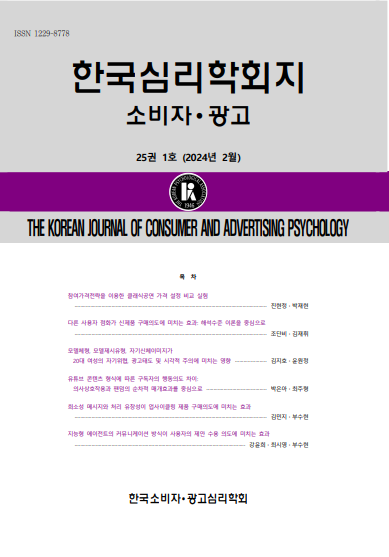open access
메뉴.png)
open access
메뉴 ISSN : 1229-8778
ISSN : 1229-8778
업사이클링은 버려지는 폐기물이나 쓸모없는 제품을 새롭게 디자인하여 원래보다 더 가치 있는 제품으로 재탄생 시키는 것을 말한다. 업사이클링 제품은 특정 재료를 선별 및 수거하여 제작할 뿐만 아니라, 일반적인 대량 생산 제품과 차별화하기 위하여 독창적인 디자인을 적용하거나 수작업 방식의 생산을 고수하기 때문에 한정된 수량만 제공되는 경우가 많다. 이로 인해 업사이클링 제품의 가격은 같은 제품군의 준거가격보다 높은 편이며, 이를 극복하기 위하여 소비자에게 업사이클링 제품의 친환경 가치를 강조하는 커뮤니케이션 전략이 주로 사용된다. 본 연구는 이와 같은 업사이클링 제품의 특징에 초점을 두고, 수량 한정에 기초한 희소성 메시지와 업사이클링 타당성을 알기 쉽게 설명해주는 처리 유창성이 업사이클링 제품의 구매 의도에 미치는 효과를 검증해보려고 하였다. 실험은 희소성 메시지(처치 조건 vs. 통제 조건)와 처리 유창성(고 조건 vs. 저 조건)에 따라 2 × 2 집단 간 요인설계 되었다. 121명의 참여자를 실험조건에 무선할당하고 각 참여자에게 조건에 따른 광고를 노출한 뒤 광고된 업사이클링 제품의 구매 의도를 측정한 결과, 희소성 메시지의 주 효과와 두 변인 간 상호작용 효과가 통계적으로 유의하였다. 구체적으로, 수량 한정 희소성 메시지를 제시할 때 업사이클링 제품 구매의도가 더 높으며, 이러한 구매촉진 효과는 처리 유창성이 높은 조건에서 더 명확하게 나타났다. 따라서 업사이클링 제품의 광고에는 희소성 메시지를 활용하는 것이 바람직하며, 업사이클링의 타당성 또는 적합성을 쉽게 이해시켜줄 수 있는 명료한 메시지(처리 유창성 고 조건)를 함께 사용하는 것이 바람직하다.
Upcycling is the redesign of discarded waste or unwanted products to make them more valuable than they were originally. Not only are upcycled products made by selecting and collecting specific materials, but they are also often available in limited quantities because they are uniquely designed or handmade to differentiate them from typical mass-produced products. As a result, the price of upcycled products tends to be higher than the standard price of the same product category, and communication strategies that emphasize the environmental value of upcycled products to consumers are often used to overcome this. This study focuses on the characteristics of such upcycled products. The purpose of this study was to test the effect of scarcity messages based on limited quantities and processing fluency, which explains the feasibility of upcycling in an easy-to-understand manner, on purchase intention of upcycled products. The experiment was a 2 × 2 between-subjects factorial design with scarcity message (treatment vs. control) and processing fluency (high vs. low). 121 participants were randomized to the experimental conditions and each participant was exposed to a condition-specific ad. We then measured purchase intentions of the advertised upcycled products and found that the main effect of the scarcity message and the interaction effect between the two variables were statistically significant. Specifically, intention to purchase the upcycled product was higher when presented with a limited quantity scarcity message, and this effect was more pronounced in the high processing fluency condition. Therefore, it is recommended that scarcity messages be utilized in the advertising of upcycled products, preferably in conjunction with clear messages that facilitate understanding of the feasibility or suitability of upcycling (high processing fluency condition).
